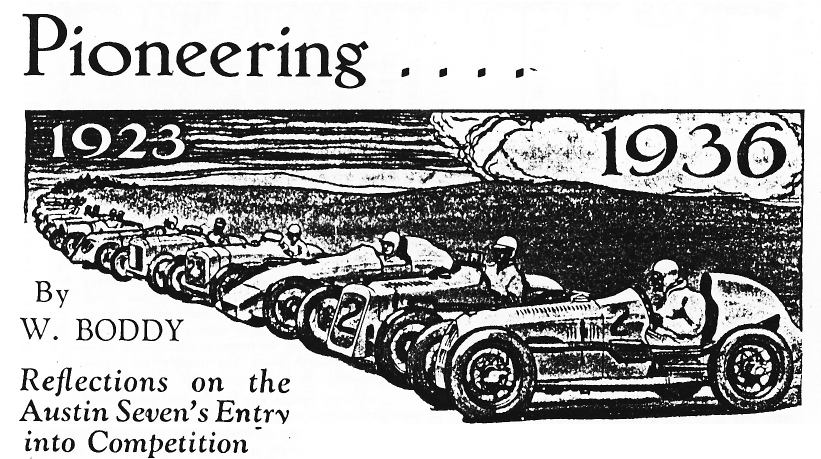

TODAY,
with the Austin Seven an established fact, the wonderful little white,
single-seater Austin lapping the "mountain" circuit at Brooklands to
the tune of over 70 m.p.h. skilfully piloted by Driscoll, or devouring the
railway straight at speeds of over 80 m.p.h., we are apt to forget that even
the Seven was once unknown. Its amazing achievements may seem rather
commonplace when they become a regular occurrence, and thus it is worth while
to recall the first appearance of the Seven in the racing world and how it
performed in comparison with the present competition models.
It
is interesting to discover that as early as Easter, 1923, the Austin Seven
figured amongst the race-winners. In what then must have seemed an absurdly
tiny racing car, Capt. Arthur Waite headed the long list of subsequent Austin
victories by winning his race at the Brooklands Easter Meeting of 1923. His
average speed was 59 m.p.h. The
performance created a considerable stir, and amongst the people who were more
than temporarily impressed was E. C. Gordon-England, at the time walking with
sticks as a result of a gliding accident. Shortly afterwards he commenced his
long and noteworthy run of successes by taking Class Records at nearly 80
m.p.h., including the coveted "hour" at 73 m.p.h. In the 1923 two
hundred mile race England entered the little Austin, which was up against the
1,100 c.c. cars, as no 750 c.c. division was recognised at that time. The
performance in that race was really magnificent, the Baby running through
non-stop to second place in the class, averaging nearly 77 m.p.h. for the whole
distance.
For
1924 the Junior Car Club recognised the 750 c.c. class in the two hundred mile
race, and the general esteem of the Austin Seven a year after its entry into
racing is revealed by the fact that no fewer than nine of these cars were
entered. They
had no rivals, and the winner again proved to be England, this time at 75.61
m.p.h. The lower speed is accounted for by the loss of one con-rod and piston
towards the end, but even so, it surpassed that of every 1,100 c.c. car with
the exception of the class-winning Salmson! Incidentally, England, himself no
lightweight, carried a passenger throughout and, although his car was not
specially streamlined, one lap was done at 80.33 m.p.h.
In
1925 a supercharged edition of the Seven appeared at Brookland which was
capable of well over 90 m.p.h. and was successful in capturing many records at
around 85 m.p.h. That year Gordon England once again won
the two hundred mile
race, proving that the Austin was equally at home over the semi-road circuit as
it had been previously round the outer circuit only. It
was in this 1925 event that Capt. Waite ran a beautifully streamlined Seven,
bored out to 776 c.c. to place it in the 1,100 c.c. section.
To
continue this history would fill many pages where we came to the stirring
period when 100 m.p.h. first came within the possibilities of the baby car,
achieved by Leon Cushman at Brooklands during August, 1931 But
the purpose of this article is merely to remind you of those very early days of
baby car history when the Austin Seven entered, untried, into the stern field
of competition, and did incredibly well right from the start.
Few
people expected a purely utility car - the world's smallest - to be much use in
serious racing. Yet with the sole addition of two carburetters and a special
camshaft, the Baby Austin happily averaged over 76 m.p.h. for 200 miles on its
first appearance in a classic contest.
In
conclusion, ignoring the classic contests altogether, it is instructive to note
the best winning average speeds recorded year by year by Austin Seven cars, in
the ordinary Brookland short handicap events that constitute the private
owner's playground.
The
very first victory of all was gained at 59 m.p.h. in 1923.
During
1924 Gordon England won a race at 75 m.p.h.
The
first Brooklands win at over 80 m.p.h. was registered in 1928 by G. Hendy,
whose Austin won a 75 m.p.h. Short Handicap at 80.20 m.p.h.
The
1929 President's Gold Plate event went the famous B.C. Austin Special
"Mrs. Jo-Jo," at 80 m.p.h., and a "mountain" contest was
won by Capt. Waite at 62.87 m.p.h.
The
speed of over 83 m.p.h. achieved by the winning Austin in the 1930 five hundred
mile race, driven by S. C. H. Davis and the Earl of March was truly remarkable.
The
1931 Relay Race went to the Austin Team at nearly 82 m.p.h. and, reverting to
short handicap, A. B. Gilbert that year won a Club Sports Contest in a sports
model at 85.57 m.p.h. lap speed.
By
1932 lap speeds of over 90 m.p.h. were fairly common and in winning a race at
the Easter Meeting Driscoll lapped at 102.48 m.p.h.
And
last season various Austin Sevens were lapping the difficult
"mountain" circuit at from one to seven or eight m.p.h. faster than
Gordon England and Capt. Waite was winning races straight away in 1923. Truly a
great marque.